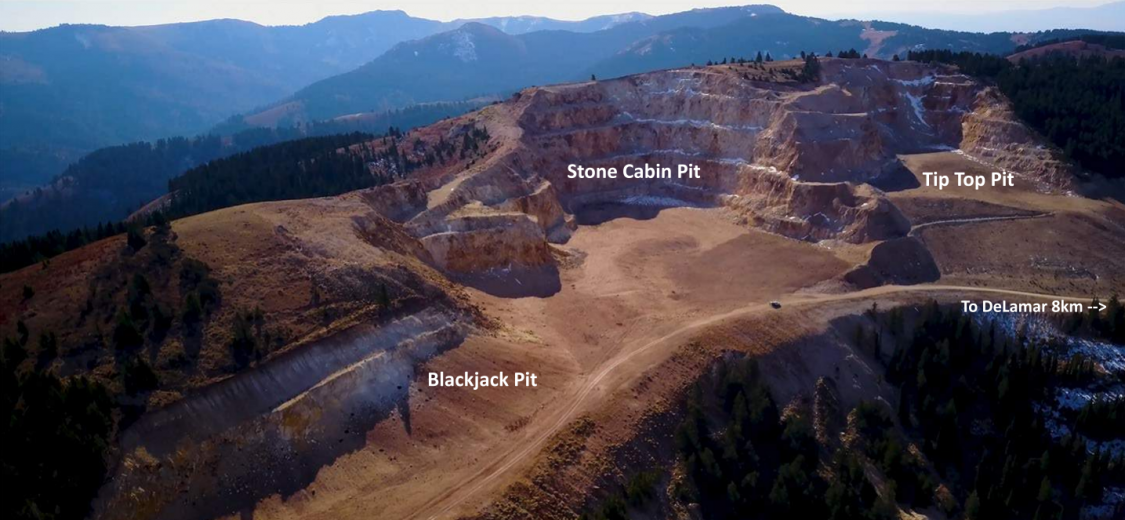Both fissure veins and the bulk-mineable type of mineralization are present at Florida Mountain and both have contributed to past gold and silver production. The veins cropped out intermittently near the crest and on the flanks of Florida Mountain, in some cases with lateral continuity of 1.6 kilometers (1 mile) or more, even though vein widths were usually only a few meters or less. Dips are reported to be 75° to 80° W, transitioning in their northern extents to steep east dips (Piper and Laney, 1926).
Mosser (1992) summarized the vein mineralization as follows:
“…Mineralization is strongly controlled by NNW-trending faults, and to a lesser degree by arcuate and ENE structures. Host rocks display a definite influence on mineral distribution. Within the granodiorite and basalt, where most of the historic production occurred, the veins are narrow and tight. However, within the more reactive and permeable quartz-latite and rhyolite units, the mineralization is more disseminated so that significant bulk mineable potential exists… The vein deposits are dominated by quartz and adularia gangue. Quartz occurs in a variety of forms in a definite paragenetic sequence…. Hypogene gold and silver mineralization varies little with depth across known levels and is dominated by electrum, acanthite, and the silver sulfo-selenide aguilarite….”
In the quartz latite and rhyolite, at least some of the veins branch upward into multiple narrow veins and vein-cemented breccia, separated by intensely altered rhyolite, to form sheeted vein and breccia zones as much as 6.1 meters (20 feet) or more in width. These broader sheeted vein and breccia zones comprise the bulk-mineable style of mineralization at Florida Mountain, particularly where adjacent fracture networks and flow bands in the rhyolite have been permeated with narrow, discontinuous quartz and breccia veinlets. Four such zones were described by Mosser (1992), referred to as the Tip Top, Stone Cabin, Main Trend (Black Jack), and Clark deposits. The mineralogy and paragenesis of the gold and silver mineralization are similar, if not the same, as that described for the fissure veins. Details of the mineralogy and a fluid inclusion study were presented by Mosser (1992).1
1. NI 43-101 Technical Report for the DeLamar and Florida Mountain Gold-Silver Project, Owyhee County, Idaho, USA. Dated October 31, 2023.
The geology of the Florida Mountain area has been described in general by Lindgren (1900) and Piper and Laney (1926). More detailed studies were carried out by Earth Resources and NERCO as documented by Lindberg (1985), Porterfield and Moss (1988), and summarized by Mosser (1992). The oldest stratigraphic unit is the Late Cretaceous Silver City granite, which is unconformably overlain by the mid Miocene lower basalt to trachyandesite lavas. The granite and lower basalt are overlain by a sequence of andesitic volcanic-sedimentary and tuffaceous lacustrine rocks, which are in turn intruded and overlain successively by units of quartz latite, tuff breccia, and porphyritic rhyolite of the Silver City rhyolite (e.g., Lindberg, 1985). As at DeLamar, the tuff-breccia unit is interpreted as a near-vent pyroclastic unit erupted as a precursor to emplacement of the rhyolite flows and domes.
In contrast to the DeLamar area, the Silver City granite crops out on the flanks of Florida Mountain and was extensively penetrated by workings of the historical underground mines. It was designated granite by the Integra geologists. Field relations demonstrate the lower basalt flows partially buried an erosional, paleotopographic high of Silver City granite. Surface exposures and maps of the underground workings, as well as early drilling at Florida Mountain, led Lindberg (1985) to infer the granite forms a northeast-trending ridge beneath a relatively thin capping of quartz latite, tuff breccia, and one or more flows of rhyolite lava.
The Earth Resources, NERCO and Integra geologists interpreted certain rocks at Florida Mountain to represent volcanic vents from which portions of the rhyolite flows and possibly tuffs were presumably erupted, and which later were important foci of hydrothermal activity, alteration, and mineralization (e.g., Porterfield and Moss, 1988; Mosser, 1992). However, exposures of rock units at Florida Mountain were generally poor prior to the start of mining by Kinross in 1994 as explained by Lindberg (1985), and the criteria used by the above authors to define the vent facies units and to delineate their geometries are not known to the authors. Moreover, most of the drilling at Florida Mountain was done by conventional rotary and RC methods, which can make outcrop-scale rock textural characteristics much more difficult, to impossible, to discern and correctly interpret.1
1. NI 43-101 Technical Report for the DeLamar and Florida Mountain Gold-Silver Project, Owyhee County, Idaho, USA. Dated October 31, 2023.
Kinross commenced production at Florida Mountain in 1994, while continuing operations at the DeLamar mine, moving Florida Mountain ore to the DeLamar mill via an 8.4-kilometer (5.2 mile) haul road. Material was excavated from three open pits on the west side of the crest of Florida Mountain from 1994 through 1998. These were named the Stone Cabin, Tip Top, and Black Jack pits. The Florida Mountain operation was formally referred to as the Stone Cabin mine in permitting and other documents. Gierzycki (2004b) estimated that 124,500 ounces of gold and 2.6 million ounces of silver were produced from the Stone Cabin mine in 1994 through the end of mining in 1998, based on an examination of files and company reports at the DeLamar mine.1

1. NI 43-101 Technical Report for the DeLamar and Florida Mountain Gold-Silver Project, Owyhee County, Idaho, USA. Dated October 31, 2023.